
|
Lesson Two
by Dr Jamie Love |

|
 and
and  licensed under a Creative Commons Attribution-ShareAlike 4.0 International License.
licensed under a Creative Commons Attribution-ShareAlike 4.0 International License.

|
Lesson Two
by Dr Jamie Love |

|
|
Eukaryotic cells go through a cell cycle as their "life history".
The cell cycle is a series of stages through which the cell passes between divisions and it is composed of three stages easily identified through the microscope. |

|

| 1. Interphase is the period between divisions when nothing seems to be happening. |

| 2. Nuclear Division is when the genetic material is dividing and you can see the chromosomes. As you know eukaryotic cells have two types of nuclear division - mitosis and meiosis. Therefore this is often called M phase. During M phase one mother nucleus becomes two daughter nuclei. |

| 3. Cytokinesis divides the cytoplasm of the mother cell into two daughter cells and this is very obvious under the microscope. It is during cytokinesis that one mother cell becomes two daughter cells. |
|
Personally, I've never cared for this diagram - which dominates
the textbooks - because some students interpret it to mean that
a cell returns to itself!
When you look at this diagram remember that it is a cycle that involves a cell division at cytokinesis. The daughter cells then start their own cell cycle at the point just after cytokinesis. Maybe this diagram to the right will make that clear. The big mother cell divides at cytokinesis into two smaller daughter cells. Both these daughter cells then start their own cell cycle. (I've had to turn them around so you can see how the cycles connect.) |
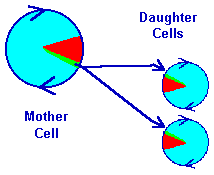
|
Interphase dominates the cell cycle and it is often called the "gap phase" in the cell cycle because it represents a period in which nothing seems to be happening. We often abbreviate it as G phase to distinguish it from M phase. The microscope was not very informative about G phase so biologists turned their attention to its chemistry. They soon discovered that DNA is synthesized (duplicated) during G phase. That information allows us to split G phase into two other gaps separated by the period of DNA synthesis.
Today, interphase is subdivided into these three subphases.
|
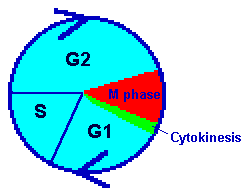
|
G1 is the time when the cell recovers from the previous cell division
and grows larger. A cell does most of its "work" in
G1. That is, most cells spend their time in G1 performing whatever
is required. If the cell is a liver cell it spends most of its
time metabolizing materials while in G1. If the cell is a macrophage
it spends most of its time in G1 eating any invading organisms.
If the cell is an osteoblast it spends most of its time in G1
laying down bone materials.
Cells that do not divide are usually "arrested" (as
we say) in G1. They never move to S phase so they never replicate
their DNA and it is because they never replicate their DNA that
they cannot move further through the cell cycle. Most neurons
(nerve cells) are arrested (stuck) in G1.
The last part of G1 prepares the cell for S phase. We cannot see
that occurring but several biochemical "signals" can
be detected that cause the cell to move on to S phase.
You will learn all about the biochemistry of S phase (DNA replication) in a later course. Do NOT confuse DNA replication with nuclear or cellular division. DNA replication is a biochemical event that cannot be seen with the microscope. Nuclear division (M phase) and cellular division (cytokinesis) are nuclear and cellular events easily observed through a microscope. Also, there is one important exception in a special cell cycle where the DNA is not duplicated. But let's not get too far ahead of ourselves here. Let's keep it simple to start with.
G2 is the time when the cell prepares for mitosis and cytokinesis. Of course, when you think about it, a cell in G2 has twice as much DNA in it as it had before, in G1 - because of the S phase. If a cell had one picogram of DNA in G1, it duplicated it in S phase and it would have two picograms of DNA in G2. [A picogram is 10-12 of a gram. Don't worry about it. We rarely count DNA by its mass and later I will teach you a better way to count the genetic materials. For now, just understand that the total mass of DNA found in a cell doubles due to S phase.]
By now you are probably eager to learn all about M phase because this is the most important part of a cell's genetic "life". Subsequent lessons will cover M phase but the rest of this lesson teaches you the details of interphase and cytokinesis.
|
Interphase occurs between both nuclear and cellular divisions.
It is easily identified through the microscope because the
nuclear envelope is intact throughout interphase.
During this time the chromosomes are so decondensed (strung out) that they are invisible. |
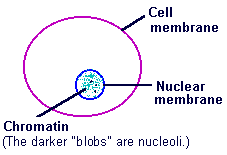
|
The chromatin (DNA and protein) that makes up the chromosomes is still there but it's so dispersed within the nucleus that only a few dark blotches of chromatin can be seen. [These dark areas of visible chromatin are called nucleoli.]
|
G1 is "early interphase" and cells in G1 have only
one centrosome.
The centrosome, not to be confused with the centromere on the chromosome, is the major organizer of chromosome movement in M phase. As you will see, the centrosome is a very important organelle ("cell organ") in mitosis and meiosis but it is present during all parts of the cell cycle. |
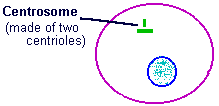
|
The centrosome is not easy to see but its location is usually
found by following the microtubule filaments that radiate from
it later in M phase. Microtubules are tiny tubular structures made of protein. They act like tiny molecular "strings" for the cell, maintaining the cellís shape and they are responsible for most of the cellís movements as well as the movement of internal organelles and chromosomes.
Here I've drawn the centrosome for you to see but, in fact,
they do not stain well, so they are usually invisible without special dyes and microscopy. In most species the centrosome is made up of a pair of centrioles - one centriole is larger than
the other and they are at right angles to each other.
Don't be confused by the fact that one centrosome contains two centrioles.
Pay attention when reading "centrioles" or "centrosomes"
- or, for that matter "centromere"!  I understand that
these words are new and similar but it very important that
you keep them clear in your mind and in your studies.
I understand that
these words are new and similar but it very important that
you keep them clear in your mind and in your studies.
[Seed plants and a few other organisms do not have centrioles. Structures specific to plant cells, called "basal bodies" seem to take the place of centrioles in most plants. Similar plant structures
might be involved in other microtubule formations that give rise to the cell plate (at cytokinesis). In point of fact, centrioles are also found in some specialized but "primitive" plants cells - kelp and ferns use
centrioles (like an animal cell) during the nuclear divisions that give rise to their motile sperm! Having said all that, don't worry or get confused. Let's limit our discussion of centrosomes of animal cells.]
Of course after G1 comes S phase when the DNA duplicates itself
but you cannot see it and that's a real shame.  During S phase
each single chromatid (inherited from the previous nuclear division)
is duplicated to give us the identical sister chromatids we see
later on. We'll come back to this "trick" later when I teach you about
M phase.
During S phase
each single chromatid (inherited from the previous nuclear division)
is duplicated to give us the identical sister chromatids we see
later on. We'll come back to this "trick" later when I teach you about
M phase.
|
During G2 the centrosome is duplicated so by late G2 the
cell has two centrosomes.
Regardless of whether a cell has centrioles or not - they all have one centrosome during G1 and two centrosomes by late G2. The centrosome count is "diagnostic" (tells us) if we are nearing M phase. |
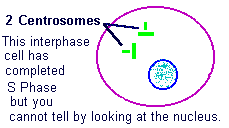
|
It is crucial that the centrosome replicates during G2 because a cell must have two centrosomes to guide the chromosomes during the M phase that follows. Any cell with two centrosomes has successfully completed S phase and is in late G2 (or M phase if you can see the chromosomes).
Of course, M phase follows G2 but I'm leaving that for later. So let's skip nuclear division for now and go straight to the third part of the cell cycle - cytokinesis or "proper" cell division. As a cell enters cytokinesis it has two nuclei formed by nuclear division during M phase. [Sometimes cells do not reform proper nuclei after M phase until cytokinesis is complete. These exceptions should not concern you for now.]
During cytokinesis the cytoplasm is divided. Most cells divide their cytoplasm pretty evenly but not all cells are so "fair" in their allocation of the cytoplasm. You may come across those exceptions in advanced courses.

|
Animal cells do not have a cell wall so they divide by a method
called furrowing.
During furrowing the cell membrane puckers inward along the cell's "equator" as if an invisible thread were tightening between the two parts. Eventually the furrowing pinches the cell in two. The "thread" is actually fibers of proteins, microtubules, attached to the inside of the cell membrane. Microtubules constrict like a muscle.
Plant cells have cell walls so they cannot divide by furrowing.
|
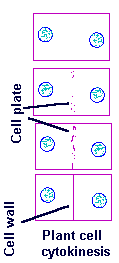
|
Mitosis ensures that both nuclei have exactly equal genetic information, but cytokinesis distributes the organelles (mitochondria, ribosomes, etc.) and cytoplasm randomly. That's OK as long as enough organelles are present so the cell will be viable.
Now you know all about interphase including G1, S phase and G2, and the features that distinguish them. You also know about cytokinesis and the difference between animal and plant cell division.
In the next few lessons you will learn the most exciting part of the cell cycle - M phase, the part of the cell cycle in which nuclear division occurs!
This work was created by Dr Jamie Love  and
and  licensed under a Creative Commons Attribution-ShareAlike 4.0 International License.
licensed under a Creative Commons Attribution-ShareAlike 4.0 International License.
| Table of Contents | Homepage | How to get a FREE copy of the entire course (hypertextbook) | Frequently Asked Questions |